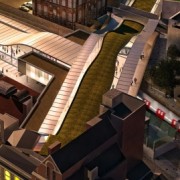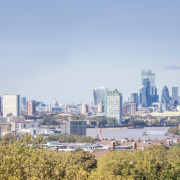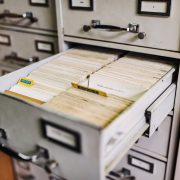Looking East from the roof of the control room near New Cross, you can just catch the sun glinting on the spire of Nicholas Hawksmoor’s Christ Church in Spitalfields in the heart of bustling East London. To the south, you can see the densely packed streets of Lewisham and, in the distance, the suburbs of Croydon.
In between, there are the gleaming new tracks of the East London Line, which from the 23rd of May – now the official opening date of the ELL – will link these disparate parts of east and south London, creating a whole new community along the line.
Yesterday, East London Lines was among the first group of media representatives to be given a sneak preview of the newest addition to London’s transport network, which has cost £770m to complete.
The new trains themselves are a feat of modern design and engineering. The standard East London Line train has 4 cars, and is designed for maximum capacity, with lots of standing room. Allan Ramsay, press officer for TFL said: “The journey length of the train is an acceptable length of time to stand, and this is why so much standing space has been made available.”
The trains have been designed to match those of the Underground network. Even the seats are laid out in the same way as seats on the tube. This makes getting on and off the train far more efficient than with the airplane style seating, seen on most overground trains.
And with these new trains the warning of ‘mind the gap’ is a thing of the past: all of them have a sloped door entrance, so wheelchair users can alight easily.
Even the East London Line colour scheme has had thought put into it: “We kept it the same as the original line colour scheme so the re-use of the old signs would be easy” said Clare Mann, the general manager of the ELL.
As well as taking a ride on one of the new trains, the party was given a guided tour of the East London Line trains depot and the Operations Building Complex (OBC).
The OBC is a large minimalist grey building, with a glass roof and yellow metal meshing covering it ‘like a honeycomb’, Ms Mann observed. The building houses the driver accommodation, as well as the administrative side of ELL and the signal room, where the signalling system is one of the most advanced available.
Since 2007, 100 new drivers have been employed, mostly all new to the railway, the majority recruited locally from areas along the East London Line. In total 275 new staff members have been employed across the line, making up the 400 strong staff. Many new jobs have been created, such as station hosts, controllers, cleaners, route cleaners, supervisors and managers.
Nowhere are these new staff positions more present than Shadwell station, our first stop on the train. Anyone familiar with the old station will remember the lack of staff presence, and the horrible decor. Tony Baker, Stations Operations Manager for Transport for London shows us a small store cupboard telling us this used to be the station managers office. The staff are now clearly visible, in the ticket office, where customers will see them immediately. “There will now always be at least two visible members of staff,” Mr Baker said.
The ticket office holds a monitor for all CCTV cameras and live PA announcements can be made from the office. All the computers are touch screen for ease of use.
Mr Baker said: “It is a remarkable transformation. Out with the avocado greens last seen in 1970’s bathrooms…’’ Sam Russell, the station delivery manager, added: “We’re really keen to get down and use the station… we’re looking forward to day one.”






are they still planning to run 4 trains an hour between dalston and new cross/gate from april 4?
Hehe, i think someone may have been quoted a little too literally! The ELL uses standard MAS (multi-aspect signalling) as the rest of the national network – while there may be passive accomadation for european cab signalling (ETCS), its not being used and even if it was it would only allow a train from Poland theoretically – the 2:15 is never going to be from Warsaw, if only because european trains are wider + taller!
Can’t wait for this line to come back. New Cross to Shoreditch in one ride!
Thanks for the advice on credit repair on this particular web-site. The thing I would tell people is usually to give up a mentality that they’ll buy right now and pay later. As a society all of us tend to do that for many issues. This includes trips, furniture, along with items we would like. However, you need to separate the wants from all the needs. When you are working to raise your credit score you have to make some sacrifices. For example you can shop online to save cash or you can go to second hand outlets instead of high-priced department stores with regard to clothing.